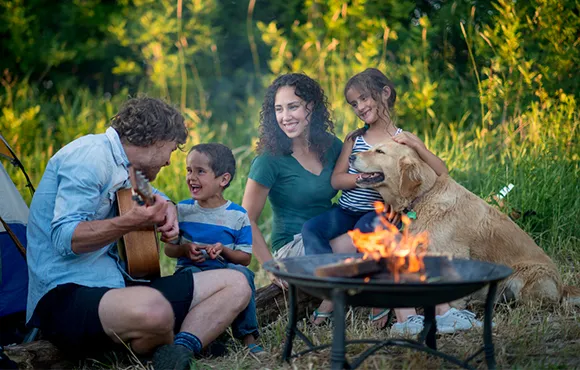Which RV is right for you? Is it an SUV with a rooftop tent or a 40-foot-long motorhome? This guide to truck campers and motorhomes will help you decide.
After this pandemic, the drive to escape in the great outdoors will be stronger than ever. Let’s dive into a few of the options we have for a rolling home away from home. It’s healthy to daydream about adventures on the horizon!
With constant stress from the daily grind and endless email notifications demanding our attention, heading outdoors — when appropriate — is the perfect way to disconnect and recharge.
Whether it’s the thrill of an off-grid excursion or a road trip to a bucket-list national park, there are recreational vehicle options to fit virtually every budget, level of experience, and desired comfort.
You could choose a rooftop tent for your daily drive that costs as little as $1,000 or an ultra-luxurious custom motorhome that costs well into six figures (and up). Understandably, it’s hard to know where to begin. Our handy guide below provides a basic understanding of some popular options worth considering.
Rooftop Tents
If setting up a ground tent and sleeping on sometimes rocky, uneven terrain has lost its appeal — or if you were never a fan in the first place — then a rooftop tent might be a step in the right direction. Tents mounted on top of vehicles have been around for the better part of a century.
What is a rooftop tent?
Imagine a canvas tent atop a rugged Land Rover parked in the heart of the Serengeti, its intrepid campers perched safely above curious carnivores wandering into their campsite.
These days, thanks to escape-fantasy photos on Instagram and the growing popularity of overlanding, there’s a wide variety of modern rooftop tents that fit on everything from a Toyota Prius to an oversized 4×4 rig. Depending on the model, these tents can sleep up to six people.
There are two main types of rooftop tents: soft-side, fold-open tents as well as hard-clamshell/pop-up tents. Soft-side, flip-open rooftop tents are generally less expensive and take up less real estate on top of your vehicle.
Hardshell rooftop tents are generally super-easy and quick to deploy and stow, but they cost more and take up a lot of room on your roof rack.
Which rooftop tent should I choose?
Because you mount a rooftop tent on the roof of a car, pickup truck, SUV, or van, the vehicle typically needs a roof rack that’s sturdy enough to carry the weight of the tent as well as its occupants.
And because the vehicle carries it during transit, it also must be secure enough to withstand wind resistance at highway speeds. The drawback here is that a rooftop tent will adversely affect your vehicle’s fuel economy.
Prices start at around $1,000 and go way up from there. It’s hard to go wrong with established brands like iKamper, Tepui, AutoHome, Roofnest, and many others.
If you want to go down the rooftop tent rabbit hole even further, check out these GearJunkie stories: “Rooftop Tents: A Primer” and “Rooftop Tents and the Love-Hate Paradox.”
Pop-Up Truck Toppers
Between rooftop tents and slide-in truck campers, there’s an emerging class of lightweight pickup bed tent toppers. These units are basically pickup truck bed toppers with built-in rooftop tents. Pricing ranges from about $5,000 to $15,000.
The big advantage of these units is that they offer a standing-height living area within the truck bed while still retaining the full functionality of the truck bed for daily gear-hauling duties.
They are also extremely lightweight, most around 400 pounds. This helps retain the truck’s gear-hauling capabilities, ride, handling, and fuel economy. It also limits the need to remove the camper system if you use the truck as a daily driver.
Have a look at our in-depth guide to this type of versatile camper option: “The Lightweight Pop-Top Truck Camper Revolution.”
Slide-In/Truck Bed Camper
If you’re like millions of Americans who already own a pickup truck, then a slide-in or truck bed camper provides a ton of home comforts in a compact, flexible package.
Different configurations of slide-in campers are available for trucks with short or long beds as well as various payload capacities. Many have cab-over compartments that add space for additional sleepers or cargo.
What is a truck bed camper?
Stabilizer legs that you deploy to various terrain are an important feature of truck campers. They allow the camper to stand on its own without the vehicle supporting it. They also allow the camper to remain at the campsite, freeing up the truck for exploration. Also, when not in use, they allow you to store the camper in a driveway or yard.
You can order truck campers fully equipped or basic and stripped down. A typical fully equipped unit will have a dedicated bed, kitchen (including stove, sink, refrigerator, microwave, etc.), a convertible seating/dining/sleeping area, bathroom facilities, and more.
Which truck bed camper should I choose?
Keep in mind that the total weight of the camper and its contents should fall within the allowable load capacity of your pickup truck.
In some cases, the burdensome load requires a heavier-duty suspension. Things like beefed up sway bars, helper springs, and airbag systems are all worth considering when setting up your truck to haul a camper.
Hellwig Products is a great resource for these products and information on what you’ll need to get your truck set up properly.
Slide-in campers fit many needs and budgets. They range in size from 8 to 20 feet, sleep up to six adults, and can cost anywhere between $6,000 and north of $50,000. There are two basic types of slide-in truck campers: hard-sided and pop-up.
Companies like Lance Camper focus on hard-sided units whereas Four Wheel Campers focuses on pop-up units, with many other brands out there to choose from that span the spectrum.
To get a good picture of the full range of hard-sided, slide-in truck camper options out there, we can look at Lance’s camper offerings. They start with the Lance 650 short-bed model, with an interior floor length of nearly 7 feet and a dry weight of 1,700 pounds.
From there, it goes all the way up to the Lance 1172 long-bed model. It has a floor length of nearly 12 feet, a dry weight of 4,174 pounds, and two slide-outs that expand the usable interior space.
In the middle sits the versatile Lance 855s short-bed model with a single slide-out, which was used on Lance’s Altimeter concept camper project.
Travel Trailers
If you want more comfort than a rooftop tent, want to keep your truck bed for outdoor gear, and don’t want to own a dedicated vacation vehicle, then a travel trailer may be the solution for you.
Just as there are different classes of motorhomes, travel trailers come in dozens of shapes, sizes, and configurations to suit recreational users’ diverse needs.
What is a travel trailer?
Most travel trailers are portable living quarters towed behind a vehicle. Others, known as “toy-haulers,” combine living space with a garage for transporting ATVs, motorcycles, or side-by-sides.
Travel trailers offer the convenience of being parked at a campsite so the tow vehicle can be used for transportation to your favorite fishing hole or hiking trail.
Travel trailers come in a range of styles, from lightweight tent trailers that can be towed behind a car to enormous triple-axle trailers that require a heavy-duty tow vehicle.
Lengths range from 8 to 40-plus feet, sleeping accommodations range from one to 10, people and prices range from about $6,000 to $160,000-plus.
Which travel trailer should I choose?
An important consideration when looking at travel trailers is the towing capacity of your car, truck, or SUV. Keep in mind that driving a vehicle while towing a trailer requires skill and situational awareness, especially when backing up or maneuvering in tight spaces like gas stations, parking lots, and campgrounds.
The added weight of the trailer limits acceleration and the ability to brake or swerve quickly. But with an appropriate vehicle and some practice, you’ll become a trailer-towing pro in no time and have a convenient, comfortable base camp for your outdoor adventures.

You can get a good feel for the variety of travel trailers on the market by having a look at a couple of our guides: “The Best Off-Road Trailers & Teardrops Under $10,000” and “13 Rugged Campers to Pull Behind Your F-150.”
RVs and Motorhomes: Class A, B, C
The different classifications of motorhomes — self-contained, self-propelled vehicles with living quarters — are a little confusing. Class A is the largest, Class B is the smallest, and Class C is in between.
What is a Class B campervan?
Because they are built on a van chassis, Class B campervans are the lightest and most maneuverable type of motorhome, making them easy to drive and park.
As a dedicated recreational vehicle, a campervan can be kept stocked with gear and supplies so you can escape at a moment’s notice. Many vans are also extremely fuel-efficient and easy to drive, which makes them usable as daily drivers as well.
Most Class B campervans provide the comforts and conveniences of home, including dining and kitchen facilities, sleeping quarters, a bathroom, and ample storage.
Because of their compact size, they make efficient, multipurpose use of space. The camper can arrange cushions used for couches and dinettes by day to create sleeping areas at night. Refrigerators, microwave ovens, running water, flushing toilets, satellite TVs, and Wi-Fi are but a few of the features available on today’s campervans.
Class B campervans range from 15 to 25 feet in length, sleep up to four people, and cost anywhere from $60,000 to $150,000-plus.
A super-nice and well-equipped example of a Class B campervan is the Passage 144 Sprinter RV Camper Van. Midwest Automotive Designs built it on a Mercedes-Benz Sprinter van chassis with a diesel engine and fully equipped it with heat, air conditioning, a lithium-ion battery power system, a diesel generator, two LED HD TVs, and so much more.
The Passage 144 costs about $125,000 and is just under 25 feet long.
What is a Class C motorhome?
Like Class B motorhomes, those designated Class C are also built on a van chassis and retain the original cab section. The difference is that they have a wider body section and an over-the-cab sleeping/cargo area.
Because of their larger, purpose-built bodies, Class C motorhomes are typically larger, heavier, and more expensive than their Class B counterparts.
Remember, in the world of RVs, the largest motorhomes are Class A, followed by Class C then Class B. For those who want a dedicated recreational vehicle, Class C motorhomes offer more living space, more creature comforts, and a wider range of configurations than a Class B. They range in length from 20 to 35 feet, sleep as many as eight, and cost anywhere from $40,000 to $200,000-plus.
A luxury example of a Class C motorhome is the Renegade Vienna, which is built on a Mercedes-Benz Sprinter 3500 chassis with a turbo diesel engine.
Available in multiple configurations, the Vienna has a slide-out that expands both the dining and sleeping areas. It’s well-appointed for luxurious living on the road. The Renegade Vienna will set you back about $142,000 and comes in at just under 25 feet long.
What is a Class A RV?
Purpose-built from the ground up, Class A motorhomes are the ultimate in dedicated RVs. Distinguished by their boxy appearance, they most closely resemble a tour bus.
Ranging from 20 to 40-plus feet in length, Class A motorhomes may be the same length or even shorter than some Class C motorhomes, but they maximize living space to the fullest.
Some Class A motorhomes have multiple large slide-outs, greatly expanding the available interior space for cooking, dining, socializing, and sleeping. A full master’s suite and a bathroom with a tub/shower, a toilet, and a vanity area are common features.
Prices start around $60,000, but the sky truly is the limit. The most luxurious Class A motorhomes cost north of $1 million.
One of the primary distinctions among Class A motorhomes is whether it’s built on a specialized chassis and powered by a heavy-duty gas engine, or built on a bus chassis with a diesel engine mounted in the back. The industry calls these latter RVs “diesel pushers.” Class A motorhomes, especially those with high-torque diesel engines, can also tow an extra vehicle, boat, or trailer.
Fleetwood RV, a top volume RV manufacture, makes a full range of Class A motorhomes. Owners can fully customize them with a wide variety of interior materials, wood colors, appliance options, and layouts.
Its gas-powered Bounder model, which is one of the best-selling RVs of all time, is a good example of a typical Class A motorhome. Five floorplans and two slide-outs offer a king-size bed in the master suite, one or two bathrooms, and options such as bunk beds for the kids or a fold-down patio.
Home on the Road Awaits
Regardless of how comfortable or off the grid you want to be, there’s likely a tent, camper, or recreational vehicle to meet your needs. Figure out what your intended usage will be, how much you’re willing to spend, and how many people you’ll be traveling with.
Then decide whether you’ll use your existing vehicle, buy a pickup or tow vehicle, or invest in a dedicated recreational vehicle. Finally, make an honest assessment of your driving skills, the type of terrain you’ll be traveling, and where you’ll store the camper when not in use.

Before making any commitment, consider renting different types of recreational vehicles to figure out what you like and don’t like. Check out companies like Cruise America, Outdoorsy, RVshare, and others to try a range of camper options.
And if buying new is not within your budget, there’s a thriving used market for recreational vehicles and equipment.























